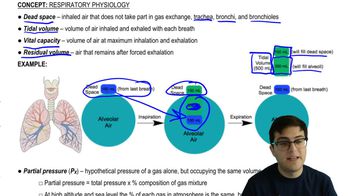Table of contents
- 1. Introduction to Biology2h 42m
- 2. Chemistry3h 40m
- 3. Water1h 26m
- 4. Biomolecules2h 23m
- 5. Cell Components2h 26m
- 6. The Membrane2h 31m
- 7. Energy and Metabolism2h 0m
- 8. Respiration2h 40m
- 9. Photosynthesis2h 49m
- 10. Cell Signaling59m
- 11. Cell Division2h 47m
- 12. Meiosis2h 0m
- 13. Mendelian Genetics4h 44m
- Introduction to Mendel's Experiments7m
- Genotype vs. Phenotype17m
- Punnett Squares13m
- Mendel's Experiments26m
- Mendel's Laws18m
- Monohybrid Crosses19m
- Test Crosses14m
- Dihybrid Crosses20m
- Punnett Square Probability26m
- Incomplete Dominance vs. Codominance20m
- Epistasis7m
- Non-Mendelian Genetics12m
- Pedigrees6m
- Autosomal Inheritance21m
- Sex-Linked Inheritance43m
- X-Inactivation9m
- 14. DNA Synthesis2h 27m
- 15. Gene Expression3h 20m
- 16. Regulation of Expression3h 31m
- Introduction to Regulation of Gene Expression13m
- Prokaryotic Gene Regulation via Operons27m
- The Lac Operon21m
- Glucose's Impact on Lac Operon25m
- The Trp Operon20m
- Review of the Lac Operon & Trp Operon11m
- Introduction to Eukaryotic Gene Regulation9m
- Eukaryotic Chromatin Modifications16m
- Eukaryotic Transcriptional Control22m
- Eukaryotic Post-Transcriptional Regulation28m
- Eukaryotic Post-Translational Regulation13m
- 17. Viruses37m
- 18. Biotechnology2h 58m
- 19. Genomics17m
- 20. Development1h 5m
- 21. Evolution3h 1m
- 22. Evolution of Populations3h 52m
- 23. Speciation1h 37m
- 24. History of Life on Earth2h 6m
- 25. Phylogeny2h 31m
- 26. Prokaryotes4h 59m
- 27. Protists1h 12m
- 28. Plants1h 22m
- 29. Fungi36m
- 30. Overview of Animals34m
- 31. Invertebrates1h 2m
- 32. Vertebrates50m
- 33. Plant Anatomy1h 3m
- 34. Vascular Plant Transport1h 2m
- 35. Soil37m
- 36. Plant Reproduction47m
- 37. Plant Sensation and Response1h 9m
- 38. Animal Form and Function1h 19m
- 39. Digestive System1h 10m
- 40. Circulatory System1h 57m
- 41. Immune System1h 12m
- 42. Osmoregulation and Excretion50m
- 43. Endocrine System1h 4m
- 44. Animal Reproduction1h 2m
- 45. Nervous System1h 55m
- 46. Sensory Systems46m
- 47. Muscle Systems23m
- 48. Ecology3h 11m
- Introduction to Ecology20m
- Biogeography14m
- Earth's Climate Patterns50m
- Introduction to Terrestrial Biomes10m
- Terrestrial Biomes: Near Equator13m
- Terrestrial Biomes: Temperate Regions10m
- Terrestrial Biomes: Northern Regions15m
- Introduction to Aquatic Biomes27m
- Freshwater Aquatic Biomes14m
- Marine Aquatic Biomes13m
- 49. Animal Behavior28m
- 50. Population Ecology3h 41m
- Introduction to Population Ecology28m
- Population Sampling Methods23m
- Life History12m
- Population Demography17m
- Factors Limiting Population Growth14m
- Introduction to Population Growth Models22m
- Linear Population Growth6m
- Exponential Population Growth29m
- Logistic Population Growth32m
- r/K Selection10m
- The Human Population22m
- 51. Community Ecology2h 46m
- Introduction to Community Ecology2m
- Introduction to Community Interactions9m
- Community Interactions: Competition (-/-)38m
- Community Interactions: Exploitation (+/-)23m
- Community Interactions: Mutualism (+/+) & Commensalism (+/0)9m
- Community Structure35m
- Community Dynamics26m
- Geographic Impact on Communities21m
- 52. Ecosystems2h 36m
- 53. Conservation Biology24m
40. Circulatory System
Gas Exchange
Problem 3`
Textbook Question
Which of the following promotes oxygen release from hemoglobin?
a. A decrease in temperature
b. An increase in O₂ level.
c. A decrease in pH
d. A decrease in carbonic anhydrase activity
 Verified step by step guidance
Verified step by step guidance1
Understand the Bohr effect: The Bohr effect describes how changes in pH and carbon dioxide concentration affect hemoglobin's affinity for oxygen. A decrease in pH (more acidic environment) or an increase in carbon dioxide concentration promotes oxygen release from hemoglobin.
Analyze the options: Consider how each option affects hemoglobin's ability to release oxygen. A decrease in temperature generally stabilizes hemoglobin's structure, making it less likely to release oxygen.
Consider the role of pH: A decrease in pH (option c) indicates an increase in hydrogen ion concentration, which can lead to a conformational change in hemoglobin, reducing its affinity for oxygen and promoting oxygen release.
Evaluate the effect of carbonic anhydrase: Carbonic anhydrase is an enzyme that catalyzes the conversion of carbon dioxide and water to bicarbonate and protons. A decrease in its activity (option d) would lead to less production of protons, potentially increasing pH and reducing oxygen release.
Conclude based on the Bohr effect: Given the options, a decrease in pH (option c) is most consistent with promoting oxygen release from hemoglobin due to the Bohr effect.
 Verified video answer for a similar problem:
Verified video answer for a similar problem:This video solution was recommended by our tutors as helpful for the problem above
Video duration:
59sPlay a video:
Was this helpful?
Key Concepts
Here are the essential concepts you must grasp in order to answer the question correctly.
Hemoglobin and Oxygen Binding
Hemoglobin is a protein in red blood cells responsible for transporting oxygen from the lungs to tissues. It binds oxygen in the lungs and releases it in tissues where oxygen levels are lower. The binding and release of oxygen are influenced by various factors, including temperature, pH, and the presence of other molecules like carbon dioxide.
Recommended video:
Guided course

Oxygen Dissociation Curve and the Bohr Shift
Bohr Effect
The Bohr Effect describes how changes in pH and carbon dioxide concentration affect hemoglobin's affinity for oxygen. A decrease in pH (more acidic conditions) or an increase in carbon dioxide levels leads to hemoglobin releasing oxygen more readily. This is because hydrogen ions and carbon dioxide bind to hemoglobin, altering its structure and reducing its affinity for oxygen.
Recommended video:
Guided course

Oxygen Dissociation Curve and the Bohr Shift
Carbonic Anhydrase Activity
Carbonic anhydrase is an enzyme that catalyzes the conversion of carbon dioxide and water into carbonic acid, which dissociates into bicarbonate and hydrogen ions. This reaction is crucial for maintaining acid-base balance in blood and facilitating carbon dioxide transport. A decrease in carbonic anhydrase activity would slow this conversion, potentially affecting pH and, consequently, hemoglobin's oxygen release.
Recommended video:
Guided course

Carbon

 5:55m
5:55mWatch next
Master Gas Exchange and Breathing with a bite sized video explanation from Jason
Start learningRelated Videos
Related Practice




















